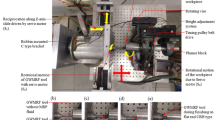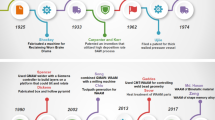Abstract
The increase in productivity due to increase in the drawing speed may be largely lost as a result of more frequent shutdown of the equipment associated with the replacement of worn dies and with wire fracture. The influence of the tool parameters on its wear and the wire fracture is analyzed. Recommendations are made regarding parameter optimization and organization of die purchase, manufacture (repair), and operation.
Similar content being viewed by others
References
Gubkin, S.I., Theory of the fluid pressure of metal in drawing, Izv. Akad. Nauk SSSR, 1947, no. 12, pp. 1663–1681.
Enghag, P., Steel Wire Technology, Orebro University, Sweden, 2009, 4th ed., p. 352.
Kolmogorov, V.L., Orlov, S.I., and Kolmogorov, G.L., Gidrodinamicheskaya podacha smazki (Hydrodynamic Supply of Lubricant), Moscow: Metallurgiya, 1975.
Bitkov, V.V., Tekhnologiya i mashiny dlya proizvodstva provoloki (Wire-Production Technology and Machines), Yekaterinburg: UrO RAN, 2004.
Nikamura, I., Kawagami, H., Matsushita, T., and Sawada, H., Wire J. Intern., 1980, vol. 13, no. 6, pp. 54–58.
Perlin, I.L. and Ermanok, M.Z., Teoriya volocheniya (Drawing Theory), Moscow: Metallurgizdat, 1971, 2nd ed.
Gubkin, S.I., Plasticheskaya deformatsiya metallov (Plastic Deformation of Metals), Moscow: Metallurgizdat, 1961, vol. 3.
Zykov, Yu.S., Frictional coefficient in the drawing of steel with optimal dies, Stal’, 1995, no. 4, pp. 48–51.
Wistreich, J.G., The fundamentals of wire drawing, Metal. Rev., 1958, no. 3, pp. 97–142.
Zimmerman, Z., Selection of operating parameters to prevent central bursting defects during cold extrusion, Wiretech, 1993.
Maxwell, T., Maintenance, design, measuring and pressure lubrication of the wiredrawing die, Wire J. Intern., 2001, May, pp. 72–77.
Semavina, A.N., Gavrilyuk, V.G., Terskikh, S.A., et al., Scale effect in cold-drawn steel wire, Fiz. Khim. Mekhan. Met., 1979, no. 2, pp. 36–40.
Gur’yanov, G.N. and Zhelezkov, O.S., Nonuniform deformation of material fibers in the working cone of the die, Izv. Vyssh. Uchebn. Zaved., Chern. Metall., 2013, no. 3, pp. 22–27.
Terskikh, S.A., Golomazov, V.A., Stukalov, V.V., et al., Manufacture of nonpeeling high-strength wire, Energ. Inform., 1974, ser. 9, issue 6.
Kennedy, M.R., Die design for better performance, Wire J. Intern., 1984, no. 12, p. 42.
Gridnev, V.N., Gavrilyuk, V.G., and Meshkov, Yu.Ya., Prochnost’ i plastichnost’ kholodnodeformirovannoi provoloki (Strength and Plasticity of Cold-Deformed Wire), Kiev: Naukova Dumka, 1974.
Siebel, E. and Kobitzsch, R., Stahl Eis., 1943, vol. 63, pp. 110–113.
Pavelski, O. and Volmer, H., Surface temperature of steel wire in drawing, Chern. Met., 1973, no. 10, pp. 20–25.
Siebel, E., Stahl Eis., 1947, vol. 66, pp. 171–180.
Tungsten carbide wire drawing dies, Wire Ind., 1992, April, pp. 350–356.
Corral, T., Die design and wiredrawing: Understanding the relationship between die specification and wiredrawing, Wire J. Intern., 2002, January, pp. 91–93.
Zheltkov, A.S., Modern manufacturing technologies for hard-alloy dies, Metallosnabzh. Sbyt, 2013, no. 10, pp. 22–28.
Adamchuk, V.S., Pudov, E.A., Semenova, O.V., et al., Increasing the wear resistance of the working channel in hard-alloy dies (diameter less than 2 mm), Stal’, 1992, no. 12, pp. 55–58.
Sunfix Wire Die Inc., What if you only used diamond on the working surface of a die?, Wire J. Intern., 2008, August, p. 11.
Zhang, A., Songshou, G., Hesheng, S., et al., Preparation and application of nanocrystalline diamond composite (NCDC) coatings for wiredrawing dies, Wire J. Intern., 2012, April, pp. 138–144.
Kean, J.M. and Wright, R.N., Commercial evaluation of TCHP dies, Wire J. Intern., 2012, August, p. 72–77.
Author information
Authors and Affiliations
Additional information
Original Russian Text © I.I. Krymchanskii, 2013, published in “Stal’,” 2013, No. 12, pp. 41–47.
About this article
Cite this article
Krymchanskii, I.I. High-speed drawing of steel wire. Steel Transl. 43, 822–828 (2013). https://doi.org/10.3103/S0967091213120073
Published:
Issue Date:
DOI: https://doi.org/10.3103/S0967091213120073




